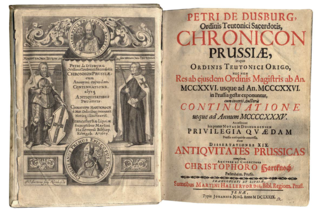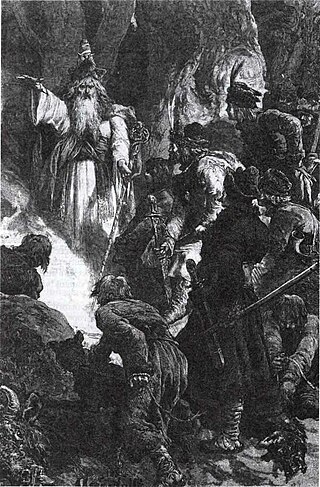
The Balts or Baltic peoples are an ethno-linguistic group of peoples who speak the Baltic languages of the Balto-Slavic branch of the Indo-European languages.

Widewuto was a legendary king of the pagan Prussians who ruled along with his elder brother, the high priest (Kriwe-Kriwajto) Bruteno in the 6th century AD. They are known from writings of 16th-century chroniclers Erasmus Stella, Simon Grunau, and Lucas David. Though the legend lacks historical credibility, it became popular with medieval historians. It is unclear whether the legend was authentically Prussian or was created by Grunau, though Lithuanian researchers tend to support its authenticity.

Old Prussians, Baltic Prussians or simply Prussians were a tribe among the Baltic peoples that inhabited the region of Prussia, at the south-eastern shore of the Baltic Sea between the Vistula Lagoon to the west and the Curonian Lagoon to the east. The Old Prussians, who spoke an Indo-European language now known as Old Prussian and worshipped pre-Christian deities, lent their name, despite very few commonalities, to the later, predominantly Low German-speaking inhabitants of the region.

Konrad I of Masovia, from the Polish Piast dynasty, was the sixth Duke of Masovia and Kuyavia from 1194 until his death as well as High Duke of Poland from 1229 to 1232 and again from 1241 to 1243.

Warmians were a Prussian tribe that lived in Warmia, a territory which now mostly forms part of the Warmian-Masurian Voivodeship in Poland, with a small northern portion located in neighbouring Russia. It was situated between the Vistula Lagoon, Łyna and Pasłęka Rivers.

Potrimpo was a god of seas, earth, grain, and crops in the pagan Baltic, and Prussian mythology. He was one of the three main gods worshiped by the Old Prussians. Most of what is known about this god is derived from unreliable 16th-century sources.

The Nadruvians were a now-extinct Prussian tribe. They lived in Nadruvia, a large territory in northernmost Prussia. They bordered the Skalvians on the Neman (Nemunas) River just to the north, the Sudovians to the east, and other Prussian tribes to the south and west. Most information about the clan is provided in a chronicle by Peter von Dusburg.
Baltic mythology is the body of mythology of the Baltic people stemming from Baltic paganism and continuing after Christianization and into Baltic folklore.

Chronicon terræ Prussiæ is a chronicle of the Teutonic Knights, by Peter of Dusburg, finished in 1326. The manuscript is the first major chronicle of the Teutonic Order in Prussia and the Grand Duchy of Lithuania, completed some 100 years after the conquest of the crusaders into the Baltic region. It is a major source for information on the Order's battles with Old Prussians and Lithuanians.
Komantas or Skomantas was a powerful duke and pagan priest of the Yotvingians, one of the early Baltic tribes. He was at the height of his power during the 1260s and 1270s.
The Treaty of Christburg was a peace treaty signed on 2 February 1249 between the pagan Prussian clans, represented by a papal legate, and the Teutonic Knights. It is often cited as the end of the First Prussian Uprising, but it was not adhered to or enforced, especially after the Battle of Krücken in November 1249, where Prussians massacred and tortured to death 54 knights who had surrendered. The treaty guaranteed personal rights to all Prussians who converted to Christianity, but it did nothing to establish peace as many Prussians did not wish to convert and the Knights swore to root out paganism. It is one of the few documents from the period that survive in full to this day. It provides a useful insight into the life and religious tensions in pagan Prussia. It also offers a small glimpse into the Prussian mythology and traditions.

Sasna or Sassen was one of the regions of ancient Prussia. It is now located in northern Poland.
Simon Grunau was the author of Preussische Chronik, the first comprehensive history of Prussia. The only personal information available is what he wrote himself in his work: that he was a Dominican priest from Tolkemit (Tolkmicko) near Frauenburg (Frombork) just north of Elbing (Elbląg) in the Monastic State of the Teutonic Order. He preached in Danzig (Gdańsk) and claimed to have met Pope Leo X and Polish King Sigismund I the Old. The chronicle was written in the German language sometime between 1517 and 1529. Its 24 chapters deal with Prussian landscape, agriculture, inhabitants, their customs, and history from earliest times to up to 1525 when the Protestant Duchy of Prussia was created. It also contains a short vocabulary of the Prussian language, one of the very few written artifacts of this extinct language. While often biased and based on dubious sources, this work became very popular and is the principal source of information on Prussian mythology. The chronicle circulated as a frequently copied manuscript and was first published in 1876. Modern historians often dismiss the Preussische Chronik as a work of fiction.
The Rzucewo was a local archaeological culture of late Neolithic. It centered at the coast of the Bay of Gdansk (Danzig) and Vistula Lagoon and extended north to the Curonian Lagoon and up to Šventoji settlement in Lithuania. It is either named after the adjacent bays or after an archeological site in the village of Rzucewo (Rutzau) near Puck.
Hermann von Wartberge was a chronicler of the Livonian Order. Born in Westphalia, Wartberge was a Catholic priest and author of the valuable Latin chronicle Chronicon Livoniale covering the history of the Livonian Crusade from 1196 to 1378. Wartberge used previous chronicles, archival documents, and personal experiences. As the narrative became more detailed around 1358, it is believed that Wartberge joined the Order around the time and began describing the events as an eyewitness. For example, in 1366 he was sent on a diplomatic mission to Gdańsk (Danzig) and took part in numerous military campaigns against the pagan Grand Duchy of Lithuania. Wartberge provided extensive details on localities of the frequent raids and on construction of Livonian fortresses. The chronicle was preserved in the State Archives in Gdańsk and was first published in 1863 by Ernst Strehlke in Scriptores Rerum Prussicarum. Translations into Lithuanian and Latvian were published in 1991 and 2005.

The so-called Sudovian Book was an anonymous work about the customs, religion, and daily life of the Old Prussians from Sambia. The manuscript was written in German in the 16th century. The original did not survive and the book is known from later copies, transcriptions and publications.

The Prussian mythology was a polytheistic religion of the Old Prussians, indigenous peoples of Prussia before the Prussian Crusade waged by the Teutonic Knights. It was closely related to other Baltic faiths, the Lithuanian and Latvian mythologies. Its myths and legends did not survive as Prussians became Germanized and their culture went extinct in the early 18th century. Fragmentary information on gods and rituals can be found in various medieval chronicles, but most of them are unreliable. No sources document pagan religion before the forced Christianization in the 13th century. Most of what is known about Prussian religion is obtained from dubious 16th-century sources.
Kriwe Kriwaito or simply Kriwe was the chief priest in the old Baltic religion. The Baltic peoples call their eastern neighbours krievs or krievai, and Russia is called Krievija. Scientists believe that, most likely, such a name comes from the name of an ancient union of tribes that lived at the source of the rivers Dvina, Volga and Dnieper, and called Krivichi, or Krivichs. Primarily from the 16th-century writings of Simon Grunau, the concept of kriwe became popular during the times of romantic nationalism. However, lack of reliable written evidence has led some researchers to question whether such pagan priest actually existed. The title was adopted by Romuva, the neo-pagan movement in Lithuania, when Jonas Trinkūnas was officially installed as krivių krivaitis in October 2002.
Alka or alkas is the name of a sacred place or a place for burning sacrifices in Baltic religion. In Latvia and Lithuania alka(-s) and elks is the most widespread component in the toponyms for sacred sites. 120 hills, 70 fields and 50 water bodies with such word in their name have been registered.

Lizdeika was a semi-legendary pagan priest (krivis) in the 14th-century Grand Duchy of Lithuania. He is associated with the legend of founding of Vilnius recorded in the 16th-century Lithuanian Chronicles. The legend became popular durign the 19th-century romantic nationalism.











